





















|
Brits take over Hanks
The British Chamber of Commerce Thailand (BCCT) held their monthly Eastern Seaboard networking evening at the Henry J Bean’s Bar and Grill outlet of the
Amari Orchid Resort. It was certainly an international evening which was sponsored by Schenker (Thai), relocation experts with their head office in Germany, but looked after in
this country by their very British MD, John Quarmby.
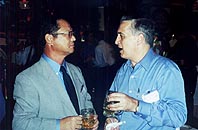 David Nardone (right) of Hemaraj
Land and Development talks business with a friend David Nardone (right) of Hemaraj
Land and Development talks business with a friend
While stiff upper lips, bowlers and furled umbrellas were to the fore, with David Wyatt, the Trade and Investment Counsellor from the British Embassy in
attendance, and Anglo-Saxon Barry Soanes passing out business cards for the Britannia Pub in Ban Chang with Boadicea emblazoned on them, the lack of international boundaries
was evident with German Hans-Dieter Westphal of Rieckermann Thai, Swiss Hans Banziger of Cafe Paradise and American David Nardone of Hemaraj Land and Development all getting
down to the serious business of helping chamber members with commercial opportunities wherever they could be mutually beneficial.
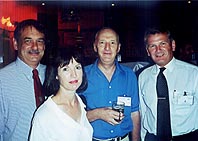 (Back L to R) Simon Lesley, David
Wyatt from the British Embassy and Andrew Wood, GM of the Royal Cliff Beach Resort (Back L to R) Simon Lesley, David
Wyatt from the British Embassy and Andrew Wood, GM of the Royal Cliff Beach Resort
While times are still tough for many companies on the Eastern Seaboard, the general feeling in the chamber members was that now at least they knew where the
tunnel was located, so the light at the end of it was that much closer!
|
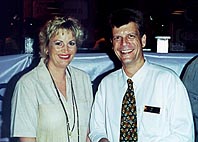 Michael & Marion Vogt of the
Amari Orchid Resort worked hard to make sure the beer flowed and the food kept coming Michael & Marion Vogt of the
Amari Orchid Resort worked hard to make sure the beer flowed and the food kept coming
The Pattaya Mail will carry notice of the next month’s BCCT networking evening.
|
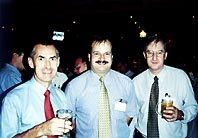 (L to R) Schenker (Thailand) MD
John Quarmby, the executive director of the British Chamber of Commerce Thailand Greg Watkins and Robin Hyde from Schenker (Thailand). (L to R) Schenker (Thailand) MD
John Quarmby, the executive director of the British Chamber of Commerce Thailand Greg Watkins and Robin Hyde from Schenker (Thailand). |
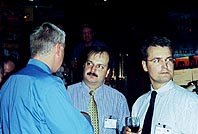 Greg Watkins (centre), a good
listener, is also good at mingling and does a commendable job of making sure he chats with as many people as possible during these networking evenings Greg Watkins (centre), a good
listener, is also good at mingling and does a commendable job of making sure he chats with as many people as possible during these networking evenings |
ATCC May: Busy (Ness) - As Usual
Story and photos by Peter Cummins
May was so busy and packed with activities for the Chamber, the management board and the Australian Thai Chamber of Commerce (ATCC) membership at large, that
it almost warranted the immortal seafaring distress signal “May-day, May-day”.
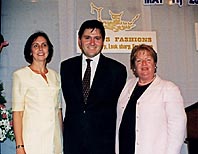 Hugh Mosley, President of ATCC,
poses with Kathy and Coralee Hugh Mosley, President of ATCC,
poses with Kathy and Coralee
Among the many events were the Sundowners at the Australian Embassy, sponsored by the Bangkok Marriott Resort and Spa, and the Eastern Seaboard Sundowners,
sponsored by Temple Bar International, held again at the splendid Garden Beach Resort, Pattaya. As usual, the Seaboard Sundowners was combined with a visit to the ATCC-supported
Ban Khao Huai Mahad School in Ban Chang, Rayong Province, on this occasion to open the multi-purpose sports facility, built with funding donated by the Chamber members.
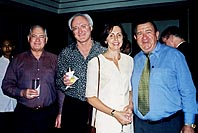 The Australian Ambassador, HE
Miles Kupa (2nd left) enjoyed the farewell party for Kathy (2nd right). The Australian Ambassador, HE
Miles Kupa (2nd left) enjoyed the farewell party for Kathy (2nd right).
Then there was “The Friends of Fred Dinner” to honour the work done by Gabi and Fred Hollows in the 1970s, when they dedicated their time and effort to
helping Australian Aboriginal people through the National Trachoma and Eye Health Program, pursuing the philosophy that blindness was preventable. The Aboriginal experience is
now being applied in partnership with China and several Southeast Asian countries, particularly our host country Thailand. The dinner was organized at the Grand Pacific Hotel
as a focal point in the “Friends of Fred Forum”.
Other functions included a breakfast briefing with the NT Asian Relations Minister H.E. Daryl Manzie but the May highlight was, undoubtedly, the superb
“Goodbye Kathy, Hello Coralee” evening.
Changing of the guard
With heavy hearts, the Chamber bade farewell to Kathy Lindsay, the dynamic, hard-working and personable executive director over many years. Chamber president
Hugh Mosley paid a fine tribute to Kathy and wished Kathy, husband Peter and son Michael all happiness and success in Sydney where Peter has gone back to ‘home base’ at the
“Australian”.
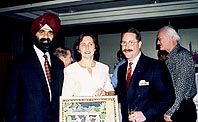 The sponsors with Kathy at the J.W.
Marriott reception. H.E. Miles Kupa is at right The sponsors with Kathy at the J.W.
Marriott reception. H.E. Miles Kupa is at right
With the J. W. Marriott Hotel and Raja’s Fashions providing what was aptly described as “heavy hors d’oeuvres” - a sumptuous spread, in fact - and
the Chamber sponsoring rivers of beer, champagne and wine, the party did, indeed, constitute a worthy send-off to Kathy and a big, hearty welcome to the incoming executive
director of ATCC, Coralee Lane.
Coralee accepted the mantle passed on by Kathy and praised her predecessor who, as a “true professional”, ensured that the transition was smooth and
complete, not overlooking any details in preparing the incumbent for the complexities of managing the broad range of the Chamber’s diverse activities.
Fashion vouchers and a dinner for two at the J. W. Marriott’s New York Steakhouse were raffled by the joint sponsors and, to ensure that no-one went home
empty-handed (I can assure the sponsors that everything else was ‘full’), a gift package awaited all at the exit.
The Sundowners
The Bangkok Marriott Resort and Spa, opened recently under the management of Michael Burchett, vice president of operations for the Royal Garden Resorts
Group, was a generous sponsor for the May Sundowners at the embassy, with the Royal Garden Resort’s renowned Sushi Bar a focal point in the expansive embassy second floor
reception/exhibition area.
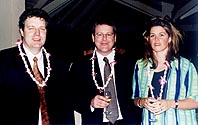 Temple Bar International
management team Temple Bar International
management team
The usual capacity crowd heard Michael’s plans for development of the Resort and Spa concept at the Royal Garden facilities around the Kingdom. He
referred, specifically, to the re-branding of the Royal Garden Resort Hua Hin as the Hua Hin Marriott Resort and Spa and the forthcoming upgrading of the Royal Garden Resort
and Plaza in Pattaya, to be known shortly as the Pattaya Marriott Resort and Spa.
Meantime, the Eastern Seaboard Sundowners, back to the seafront area of the Garden Beach Resort, Pattaya, for the second successive time, was also fully
patronized, with the large group of attendees enjoying the excellent food, beer and wine, in the exuberant ambiance of the southerly monsoon blowing in from the Gulf.
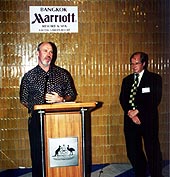 Michael Burchett, introduced by
Gary White, addresses the May Sundowner group Michael Burchett, introduced by
Gary White, addresses the May Sundowner group
The Monsoon made an ideal prop for Angela Smithbaker, senior client manager of Temple Bar International (Thailand) who, dressed in a long green/blue
sari-type outfit, looked absolutely stunning as the garment swirled in the wind - not to mention her own long tresses dancing in unison. But, we DID concentrate on Angela’s
message and her lucid presentation of various investment portfolios.
The talented songstress and the guitarist provided great entertainment, with the song-bird totally at ease in a red mini-skirt which absolutely obeyed the
laws of gravity, in spite of the howling southerly which occasionally entered the sound system.
Judging from the number of calling cards I accumulated and exchanged during these various sojourns, the Sundowners are the ideal medium to network, meet with
the Australian-Thai business community and, simply, enjoy a good Aussie ambience.
As one well-known columnist has been known to write: “Keep ‘em coming” - thanks to the ATCC and the long list of generous sponsors.
Myths and Legends - Celtics
by Suchard Krephitmai
The Celts were a technologically advanced and barbarous people who occupied vast areas of western and central Europe during the last half of the first
millennium BC. Although the early Celts were composed of a number of different races and tribes, and at the height of their power they spread across the vast area of Europe,
they did have a uniformity of religious idiom that enables historians to speak of a Celtic religion. They were linked by common origins and language (P-Celtic spoken in Gaul
and Britain, and Q-Celtic spoken in Ireland), some fairly common religious traditions and a close similarity of laws.
 The Celtic religion features many female deities such as a mother goddesses and war
goddesses. The Mother Goddess of the Celts was often conceived as a warrior, fighting with weapons and instructing the hero in superior secrets of warfare. Celtic deities were
tribal by nature, and each tribe or clan would have its own names for particular gods and goddesses. This accounts for the great diversity of names in Celtic mythology; there
are over 300 different names recorded. The Celts also believed that it was dangerous to name a sacred thing by its correct name, the result being that sacred things are often
referred to indirectly. The Celtic religion features many female deities such as a mother goddesses and war
goddesses. The Mother Goddess of the Celts was often conceived as a warrior, fighting with weapons and instructing the hero in superior secrets of warfare. Celtic deities were
tribal by nature, and each tribe or clan would have its own names for particular gods and goddesses. This accounts for the great diversity of names in Celtic mythology; there
are over 300 different names recorded. The Celts also believed that it was dangerous to name a sacred thing by its correct name, the result being that sacred things are often
referred to indirectly.
We gain our knowledge of the religion and mythologies of the Celtic people from three different areas in Europe: from Gaul, which is modern day France,
Britain (mainly Wales) and Ireland. Gaul and Britain were influenced by Greco Roman tradition before the advent of Christianity.
The Celts themselves did not write down their traditions, laws and genealogies, considering them to be sacred, so therefore they had to be handed down
orally. The Druids, the high priests of the Celts, spent twenty years learning the traditions and oral lessons.
The native lore of Wales and Ireland, the oldest outside of classical sources, is a great repository of pre-Christian myth and practices. Fragmentary texts
transcribed during the fourteenth and fifteenth centuries provide us with ancient legends and heroic tales, influenced by the times of the scribes. Archaeological evidence
provides us with more clues. The Celts of Ireland maintained their cultural integrity until close to 500 AD, and it is there where the pagan Celtic mythology has been best
preserved.
There are many animal symbols to be found in Celtic myths including boars, birds, serpents, fish, horses and cattle. Boars symbolise courage and strong
warriors. Power and strength is attached to the bristles of the boar, which was held in high esteem by the Celts. There are many examples of supernatural boars and their
adventures in the literary traditions of the Irish and the Welsh. The other world feast is supposed to be sustained by magical pigs which, no matter how many times they are
cooked and eaten, are alive again the next day to be cooked again.
Serpents and dragons are portents of trouble, strife and infertility. Birds can mean bad luck or bloodshed. Horses and cattle represent fertility, as do many
of the animals in Celtic legend. Horns were a powerful symbol of virility and divine power. The Celts not only gave their gods horns, but also enhanced their chances of success
in battle by wearing horned helmets. In Celtic mythology powerful opponents may use the magic of shape shifting into different animal forms during battle. The number three was
sacred to the Celts, and deities were sometimes portrayed in groups of three, or as having three heads or faces. In mythological tales, the deities or semi-divine heroes are
described as being one of three people of the same name, or as having been born three times in succession.
Antiques, are they genuine?
American silver of the colonial period, with the exception of that made in New York until the mid-19th century, relied very heavily for its designs on
English models (in New York, Dutch influence was stronger). The possibility instantly arises of wrong attribution in some cases if one is judging by style alone. A substantial
number of pieces could have been made in either country, America or England.
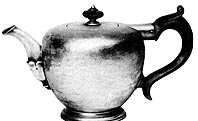 A George I bullet shaped teapot; a rare and
important item, dated from 1730 A George I bullet shaped teapot; a rare and
important item, dated from 1730
The fact that America did not adopt the hall marking system could lead one to suspect all sorts of malfeasance. If, under the strict supervision of the
Goldsmith’s Company, English silversmiths could perpetrate their own deceptions, what could American silversmiths get up to without any form of regulation?
The Marking System
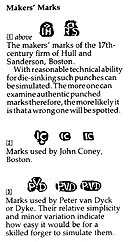
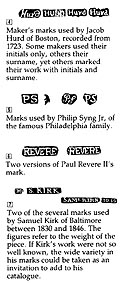 To forge an English hallmark requires the making of four, five, or even six punches. American
silver of the 18th century, however, normally bore only a maker’s mark. This might be the maker’s full name stamped in a rectangular punch, or it might be just his
initials. But either way, it is a great deal less trouble to forge these marks than those of an English assay office. To forge an English hallmark requires the making of four, five, or even six punches. American
silver of the 18th century, however, normally bore only a maker’s mark. This might be the maker’s full name stamped in a rectangular punch, or it might be just his
initials. But either way, it is a great deal less trouble to forge these marks than those of an English assay office.
There is no simple way to gauge whether a marked piece is genuine. Comparison with a mark known to be genuine by reason of its provenance can help confirm
the authenticity of a mark or to raise doubts about it. It is in the end largely a matter of experience in establishing whether marks look right, whether they have been punched
where one would expect, whether the silver looks new or has a patina and wear appropriate to a piece that is 200 years old. This takes a practised eye, but there are things to
look for when determining both the origin of the piece and catching a deception in the hallmark.
There are three main ways to fake silver with American marks. The first is to make a copy of something that one would expect to find made in the Colonial or
Federal periods and stamp it with a fake punch. Of course, this makes it an outright fake. The way is to take a piece of English silver of the period, erase the hallmarks, and
add an American maker’s mark with a forged punch. This is more difficult to detect than the first deception since the piece will be authentic in every detail of style, wear,
and patina. The third way is to find a beaten up but perfectly genuine piece of American silver, a spoon for instance, cut out its mark and solder it into a larger piece. A
thin line of solder can usually be seen however, when this is done. Be sure to look for it.
Wrong attribution of marks is another possibility. There is a considerable amount of antique English silver stamped with a maker’s mark only. Often such
items were judged by their style alone could easily have been produced in either America or England. If found in America, it is a natural assumption that they are American
until proven otherwise. An assumption like this could be made quite innocently. Or the seller may simply be turning a blind eye.
Wine appreciation made simple (Part One)
Wine is such an endlessly fascinating subject; there is so much to learn, that no one should ever feel that they know it all. At the end of the day, taste in
wine is totally subjective: no one can tell you that your taste or opinions are wrong. If you like the wine, just enjoy it. However, learning about wine will increase your
enjoyment and it should not be a daunting experience. It should be as enjoyable as drinking your favourite wine.
Over the next few weeks I hope to present a series of basic wine appreciation aimed at increasing your interest in wines. The idea is to develop a deeper
understanding and appreciation of wine but not to “preach” about the rights and wrongs about wines, nor to encourage wine snobbery.
Part 1: What is wine?
A classical definition of wine is very simple: “Wine is an alcoholic beverage obtained from the fermentation of juice from freshly gathered grapes, the
fermentation taking place in the district of origin according to local tradition and practice”.
 Fermentation is the process by which sugar is converted to alcohol by yeasts. At its
simplest, wine is made by crushing grapes and allowing the natural yeasts present on the skins to come in to contact with the natural sugars present in the juice. No other
human intervention is needed: crushed and fermented like this, any grapes will make wine. Fermentation is the process by which sugar is converted to alcohol by yeasts. At its
simplest, wine is made by crushing grapes and allowing the natural yeasts present on the skins to come in to contact with the natural sugars present in the juice. No other
human intervention is needed: crushed and fermented like this, any grapes will make wine.
The winemaker, of course, intervenes in this process in many ways to affect the quality of the wine that is produced. He must choose the best quality of
fruit; he must ensure the operation is carried out with scrupulous hygiene; he must ensure the final product is bright, clear and fit for consumption. Beyond these simple
steps, however, the winemaker can influence the wine in many other ways, taking certain decisions and actions that affect the style of the wine and how it will taste. We will
look at these actions in detail later in the course, but they include: the selection and mixture of grapes used, the method of fermentation and the treatment the wine is given
as it matures in his cellars.
Where is wine made?
The climatic conditions needed for growing quality vines are strictly defined. Vines need cool winters when the vine can “sleep” and gather strength for
the production of the next summer’s crop. Too cold though, and the roots of the vine can be damaged by frost, leading to the death of the plant. Spring must be warm and wet,
though not too wet, so that the plants can bud and produce the tiny flowers that will eventually become bunches of grapes. Summers should be long, sunny, and hot, but again,
too much heat is counter-productive, leading to scorched fruit that ripens too quickly and doesn’t have enough quality. The autumn must be gentle and relatively dry so that
the grapes can reach full maturity and the harvest can be completed before excessive rain or cold damages the mature grapes. These requirements exclude much of the northern and
southern latitudes, as these are too cold and have too little sun. The equatorial lands are also excluded, as they are too hot, with no period in which the vines can rest.
Conditions for growing vines
Unlike most agricultural crops, the grapevine does not require rich, fertile soil to thrive. In fact, soils which are too rich, too full of nitrogen and
nutrients, might produce abundant grape crops, but these will be grapes suitable for eating, not for making wine. The fruit will be too simple and sweet and lacking in complex
minerals, sugars, acids and flavours. The world’s finest wines are invariably produced from poor quality soils where few other crops would be worth planting. The great wines
of Bordeaux are produced from soil composed largely of gravel and pebbles, on a base of clay or chalk. The great Burgundies come from acidic, granite soil on a base of
limestone.
The reason for this anomaly - poor land producing great wines - is that the thinness of the soil naturally restricts the quantity of the crop, so that fewer
grapes are produced, but of higher quality.
Grapes and Wine
Curiously, wine rarely tastes or smells of grapes. The grapes from which wine is made, however, are the most important factor in taste. Wines made from the
chardonnay, for example, are said to have a taste of peaches, lemons or butter. Wines made from the cabernet sauvignon are reckoned to have flavours of blackcurrant, plums or
chocolate. Historically, old world producers stressed the importance of where the wine came from on the label, rather than what was in the bottle.
The Old World and the New
The New World had a lot to contend with in trying to compete in this marketplace. Why would we buy some strangely named bottle from Australia or California?
At first, the New World competed by simply “borrowing” famous names from the Old World: “Australian Burgundy” and “Californian Chablis” became commonplace.
International law soon caught up with this practice however, ruling that Burgundy or Chablis can only be made in Burgundy or Chablis. So even though the New World producer
could use identical grapes and identical methods to produce a high quality version of one of these famous wines, he couldn’t use any name that the consumer would recognise.
Rather than battle against tradition and prejudice, the solution the New World arrived at was to use varietal labelling. They attempted to change the whole
way we thought about, talked about, selected, chose between, and most importantly, bought wine. They educated us in the grapes from which the wine was made by stressing this,
rather than the place of origin on the label. Soon we got used to the idea of buying a bottle of chardonnay, a bottle of sauvignon blanc, a bottle of merlot or a bottle of
pinot noir.
This is perhaps the biggest change ever in the way wine is regarded by consumers: ordinary people learned to recognise wine by the grape variety used. In
turn this lead to a willingness to experiment: to buy and experience the type of wine they like, no matter where it was made, New World or Old World. Even France has recognised
that they must move into this modern world in order to compete and survive. Maybe not in the great, classical regions, but in the simpler country wines the naming of grapes on
labels is now as common in Europe as anywhere in the winemaking world.
The challenge for the newer producers is to create wines that have the quality of the “originals” from France and will have the staying power to keep
them being bought and enjoyed by wine lovers around the world for generations. For us, this results in a wider choice of wines than ever before, from a wider variety of places.
Next part of the series, we will learn all about white wines.
Ranjith Chandrasiri is the resident manager of the Royal Cliff Grand, Royal Cliff Beach Resort, Pattaya, Thailand. E-mail: ranjith@royalcliff.com or wineclub@royalcliff.com
Updated every Friday
Copyright 2001 Pattaya Mail Publishing Co.Ltd.
370/7-8 Pattaya Second Road, Pattaya City, Chonburi 20260, Thailand
Tel.66-38 411 240-1, 413 240-1, Fax:66-38 427 596; e-mail: ptymail@loxinfo.co.th
Updated by
Chinnaporn Sungwanlek, assisted by Boonsiri Suansuk.
E-Mail: webmaster@pattayamail.com
|

The Rotary Club
of Jomtien-Pattaya

Skal
International

Pattaya
Fun City
By The Sea
|